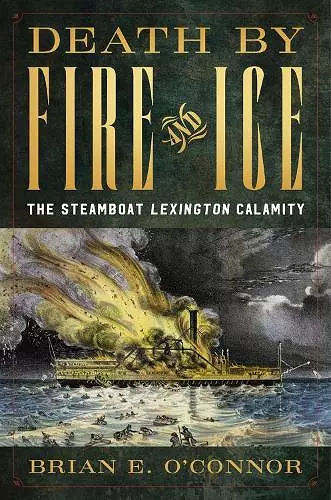Death by Fire and Ice
The Steamboat Lexington Calamity
Format:Hardback
Publisher:Naval Institute Press
Published:15th Oct '22
Currently unavailable, our supplier has not provided us a restock date

Death by Fire and Ice tells the little-known story of the sinking of the steamboat Lexington on Long Island Sound in January 1840. Built in 1835 by Cornelius Vanderbilt, the Lexington left Manhattan bound for Stonington, Connecticut, at four o'clock in the afternoon on a bitterly cold day carrying an estimated one hundred forty-seven passengers and crew and a cargo of, among other things, baled cotton. After making her way up an ice-encrusted East River and into Long Island Sound, she caught fire off Eaton's Neck on Long Island's north shore at approximately seven o'clock. The fire quickly ignited the cotton stowed on board. With the crew unable to extinguish the fire, the blaze burned through the ship's wheel and tiller ropes, rendering the ship unmanageable. Soon after, the engine died, and the blazing ship drifted aimlessly in the Sound away from shore with the prevailing wind and current.
As the night wore on, the temperature plummeted, reaching nineteen degrees below zero. With no hope of rescue on the dark horizon, the forlorn passengers and crew faced a dreadful decision: remain on board and perish in the searing flames or jump overboard and succumb within minutes to the Sound's icy waters. By three o'clock in the morning the grisly ordeal was over for all but one passenger and three members of the crew--the only ones who survived. The tragedy remains the worst maritime disaster in the history of Long Island Sound.
Within days, the New York City Coroner convened an inquest to determine the cause of the disaster. After two weeks of testimony, reported daily in the New York City press, the inquest jury concluded that the Lexington had been permitted to operate on the Sound "at the imminent risk of the lives and property" of its passengers, and that, had the crew acted appropriately, the fire could have been extinguished and a large portion, if not all, of the passengers saved.
The public's reaction to the verdict was scathing: the press charged that the members of the board of directors of the Transportation Company, which had purchased the Lexington from Commodore Vanderbilt in 1839, were guilty of murder and should be indicted. Calls were immediately made for Congress...
“This extraordinarily well-written history provides the ‘who, what, when, why, where and how’ of the disaster of the Lexington. Remarkably, John Q. Adams, Aaron Burr, Currier & Ives, Clive Cussler, Andrew Jackson, Henry Wadsworth Longfellow, Mark Twain and Daniel Webster are among many whose actions contribute to the story.” —Skip Finley, author of Whaling Captains of Color: America's First Meritocracy
“Brian E. O’Connor has woven together a captivating story detailing the rise of steam navigation in the United States, the legislation needed, and enacted, to regulate this new industry, and the explosion, burning, and sinking of the steamboat Lexington in Long Island Sound on January 13, 1840. The author tells the gripping story of the forgotten disaster that left only four survivors out of 147 people on board, and then fleshes out the consequences by delving into the resulting court proceedings and legislative acts meant to curtail such an accident from ever happening again, which, unfortunately, was never realized.” —Gene Eric Salecker, author of Destruction of the Steamboat Sultana: The Worst Maritime Disaster in American History
While others have written about Lexington, O’Connor’s work stands apart. Not only does he relate, in finely crafted prose, the details of the disaster, but employing his skills as a distinguished lawyer, he takes the reader into the intricacies of the law and the conduct of the investigations. It was a time when the nation’s ability to build powerful machines surpassed its capacity, or willingness, to regulate these new devices. In this case, a devil’s brew of failure resulted in the worst maritime disaster in the history of Long Island Sound. -- Sea History
ISBN: 9781682478042
Dimensions: unknown
Weight: 489g
232 pages